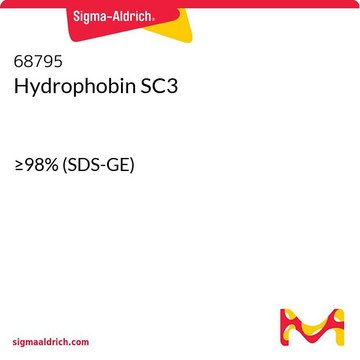Alle Fotos(1)
Wichtige Dokumente
81242
Poly(ethylenglykol)
tested according to Ph. Eur., 4,000
Synonym(e):
Macrogolum 4′000, PEG
Anmeldenzur Ansicht organisationsspezifischer und vertraglich vereinbarter Preise
Alle Fotos(1)
About This Item
Lineare Formel:
H(OCH2CH2)nOH
CAS-Nummer:
MDL-Nummer:
UNSPSC-Code:
12352104
PubChem Substanz-ID:
NACRES:
NA.21
Empfohlene Produkte
Agentur
tested according to Ph. Eur.
Qualitätsniveau
Form
solid
Mol-Gew.
3500-4500
Anwendung(en)
pharmaceutical (small molecule)
SMILES String
C(CO)O
InChI
1S/C2H6O2/c3-1-2-4/h3-4H,1-2H2
InChIKey
LYCAIKOWRPUZTN-UHFFFAOYSA-N
Suchen Sie nach ähnlichen Produkten? Aufrufen Leitfaden zum Produktvergleich
Allgemeine Beschreibung
Poly(ethylene glycol) (PEG) is a non-toxic water-soluble polymer. PEG term is used for the polymer chains with molecular weights below 20 000, while poly(ethylene oxide) (PEO) refers to the higher molecular weight polymers. PEG has various biomedical applications. It forms complexes with α-cyclodextrins. Engineering of PEG hydrogel particles by mesoporous silica (MS) templating method has been reported.
Anwendung
Poly(ethylene glycol) may be used in the following studies:
- For the modification of proteins to form the conjugates having increased circulating life and reduced immunogenicity and antigenicity.
- Preparation of hydrogels useful for the diffusion controlled delivery of proteins.
- Preparation of poly(ethylene glycol) dimethacrylate (PEGDM).
Lagerklassenschlüssel
11 - Combustible Solids
WGK
WGK 1
Flammpunkt (°F)
Not applicable
Flammpunkt (°C)
Not applicable
Persönliche Schutzausrüstung
Eyeshields, Gloves, type N95 (US)
Hier finden Sie alle aktuellen Versionen:
Besitzen Sie dieses Produkt bereits?
In der Dokumentenbibliothek finden Sie die Dokumentation zu den Produkten, die Sie kürzlich erworben haben.
Kunden haben sich ebenfalls angesehen
The clinical efficacy of poly (ethylene glycol)-modified proteins.
Fuertges F and Abuchowski A.
Journal of Controlled Release : Official Journal of the Controlled Release Society, 11(1), 139-148 (1990)
N A Peppas et al.
Journal of controlled release : official journal of the Controlled Release Society, 62(1-2), 81-87 (1999-10-16)
The use of hydrogels as carriers for protein delivery has been a subject of significant recent research. In our recent work, we have shown that diffusion controlled delivery of proteins from hydrogels containing poly(ethylene glycol) (PEG) can be possible and
Stephanie J Bryant et al.
Annals of biomedical engineering, 32(3), 407-417 (2004-04-21)
In approaches to tissue engineer articular cartilage, an important consideration for in situ forming cell carriers is the impact of mechanical loading on the cell composite structure and function. Photopolymerized hydrogel scaffolds based on poly(ethylene glycol) (PEG) may be synthesized
Complex formation between poly (ethylene glycol) and α-cyclodextrin.
Harada A and Kamachi M.
Macromolecules, 23(10), 2821-2823 (1990)
Idalis Villanueva et al.
Acta biomaterialia, 5(8), 2832-2846 (2009-06-11)
The pericellular matrix (PCM) surrounding chondrocytes is thought to play an important role in transmitting biochemical and biomechanical signals to the cells, which regulates many cellular functions including tissue homeostasis. To better understand chondrocytes interactions with their PCM, three-dimensional poly(ethylene
Unser Team von Wissenschaftlern verfügt über Erfahrung in allen Forschungsbereichen einschließlich Life Science, Materialwissenschaften, chemischer Synthese, Chromatographie, Analytik und vielen mehr..
Setzen Sie sich mit dem technischen Dienst in Verbindung.


